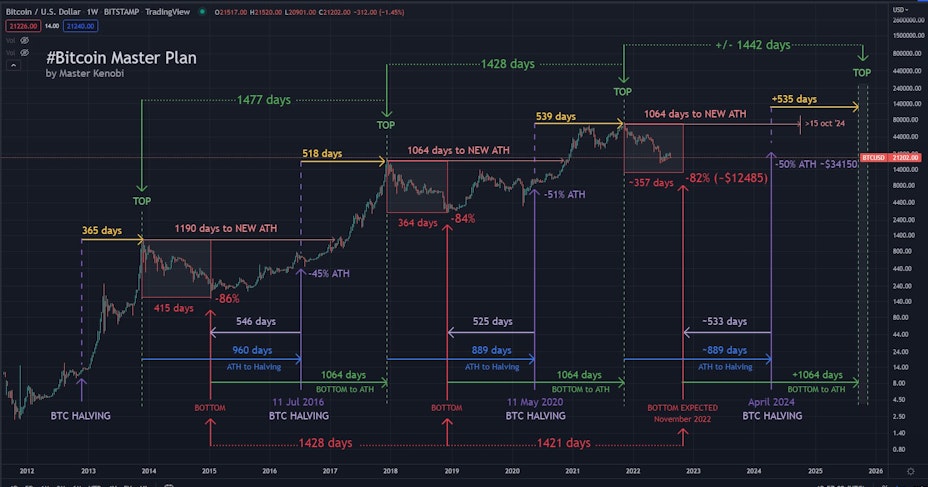Crypto exit strategy – When to sell your coins
- 5 minute read

Many new investors have no plan when it comes to selling or monetizing their purchased cryptos. If you are new to trading cryptocurrencies or stocks, this may be the first time you ask yourself, ''Do I hold or sell my cryptocurrencies?"'', or ''What is the best time to sell?'' These questions can be difficult to answer even for experts. In this article, we explain what the most common mistakes are, how to avoid them, and tell you about the most commonly used crypto exit strategies.

Table of Contents
- What is a crypto exit strategy?
- Why you need an exit strategy
- Bull Run 2024 – 2025: Bitcoin Halving as a Guide
- Technical indicators: The 200-day line
- Consider corrections during the bull run
- Limit/Stop orders
- Price targets
- The Step-by-Step Method (Dollar-Cost-Averaging).
- Return on initial investment
- HODLen
- Bull and Bear market
- Diversification
- Stablecoins - Create passive income with your crypto
- Conclusion
What is a crypto exit strategy?
Technically, an exit strategy is a plan made with the intention of liquidating a position in a financial stock. Or simply put: A plan to sell your financial holdings. The purpose of an exit strategy is to reduce losses in the event of a collapse or take profits.
Actually, you should before you buy So already have a clear plan for selling. Otherwise, you risk sinking into the cryptocurrency quagmire without a foothold. One of the biggest pitfalls with an exit strategy is if you keep it flexible. In that case, you actually have no strategy at all and you may miss all the exit opportunities.
With that explained, we discuss the most commonly used exit strategies.

Why you need an exit strategy
Holding on too long (or Hodling ) of a particular currency, for example due to greed, can result in huge losses, even if the price used to be well above the entry price. Let me give you an example.
If you decided in January to take a buy cryptocurrency and prices happen to jump by 20%, you might think that selling is the way to go. However, all your friends have decided to hold the coin. That means you would be the only one missing out on higher profits if the coin decides to moon (as crypto fanatics would call it).
This phenomenon is also known as The-Fear-of-Missing-Out (FOMO), a mistake many investors make while trading. After viewing your portfolio with satisfaction, you decide to hold the currency for another 2 months. Within those 2 months, the price of your investment has turned south, suffering a massive 50% drop. That means your investment is now worth less than it originally was.
What next? Do you sell and take the loss? Or do you hold and wait for a price recovery? Who knows, the currency may never return to its all-time-high. Many inexperienced traders sell at such a time in a panic at a significant loss. As you can see, choices like these could have been avoided if you had an exit strategy in the first place.
If you decided to sell your crypto coins when the price rose 20%, you would have made significant profits. This is why you really need to think about a solid exit strategy. Below are the top most used exit strategies in cryptocurrency.
Bull Run 2024 – 2025: Bitcoin Halving as a Guide
A market cycle in crypto refers to the periodic fluctuations in the prices of cryptocurrencies. For the upcoming Bitcoin halving, it is useful to look at the next cycle chart.

A market cycle can be divided into four phases:
- Accumulation phase : Sideways trend that is good for entering
- Preparatory phase or pre-bull run : Prices start to rise continuously
- Bull run: Prices explode and reach a preliminary all-time high
- Bear market : The bubble bursts and prices collapse again
If we apply this logic to the current cycle, then the pre-bull run would last until the autumn of 2024, which would then transition into a bull run that should last until the autumn of 2025. However, in the world of crypto, nothing is ever certain. Still, if we hold to this, cashing out in the last third of the bull run, i.e., from the summer of 2025, could be a possible option.
However, more and more voices are suggesting that the current cycle is shorter and moving faster. Instead of a few months after the Bitcoin halving in April 2024, the bull run is starting now. Given the current pace, that seems highly likely. Triggered by approvals of Bitcoin spot ETFs and a macro situation where all signs point to money printing, we would enter the bull market before the halving. The right exit date would thus not be in 2025, but early in 2024.
Technical indicators: The 200-day line
For those who like it a bit more technical and are proponents of chart analysis, the 200-day line (or MA-200) can be a useful exit indicator. This moving average indicates whether a stock, commodity, cryptocurrency, etc., is in an uptrend or a downtrend. If an underlying value trades above the 200-day line, it is in an uptrend, and vice versa.
Applied to timing in the crypto market, this could mean that the selling process starts as soon as Bitcoin breaks the moving average downwards.
Consider corrections during the bull run
Every crypto cycle consists of several smaller cycles of rises and falls. Just in the last upward cycle - from spring 2020 to the end of 2021 - there were seven correction phases that led to price drops of -17 to -55 percent.
If you don't have a plan, you run the risk of taking your chips out of the game too early by confusing a healthy pullback with the start of a bear market. Cashing out too early is the counterpart of the more common mistake of not taking any profits at all.
Which mistake you're more likely to make is probably a matter of type. Here, having a healthy self-assessment can help, i.e., knowing whether you are more driven by fear or greed. For example, those who are very speculative in the crypto sector and like to trade with leverage are more likely to belong to the second group.
Limit/Stop orders
One of the most well-known ways to limit a loss, or take profits at a certain price range, is called "Limit Orders. What this means is that you can decide ahead of time that your stocks or crypto will automatically be sold or bought at a certain price point.
For example, you have €100 to Bitcoin purchased at a price of €25,000 and you want to buy that Selling Bitcoin once the price reaches €20,000 to limit your losses. One way to do this would be to set a limit order (to sell) at the price of €20,000.
That is, as soon as the price hits that specific price target, an order to sell the asset at that specific price is added to the transaction book. The order remains open until the price limit is hit, or until you decide to cancel the order.
The convenience of limit orders is that they are automatically executed even when you are asleep. Setting limit/stop orders can be a way to limit losses or take profits. However, you should keep in mind that in the event of extreme price fluctuations, the order may not be filled in time! Nevertheless, it is always a good idea to place limit/stop orders.
To make it even easier, you can also set up an OCO order on most exchanges. This means a One Cancels the Other order. It is a combination of a stop loss and a take profit order. With this you set, for example, that you sell Bitcoin when it hits €20,000, but also when it hits €30,000. If one condition happens, the other expires. This way you know for sure that you are taking profits and also possibly your losses.
Price targets
Before you start setting price targets, it is also important to set your overall goals before you get into cryptocurrencies. Think about what you want to achieve with your investment and whether you want to invest for the long or short term. Knowing why you are investing makes making decisions a lot faster and easier.
Next, you will determine at what price targets you will sell your cryptos. After all, having targets protects you from big losses. Let's take Bitcoin as an example.
If you have invested in Bitcoin and you believe it can become worth 100,000 euros, it is still smart to set earlier price targets already. Depending on your goals, you can already sell a portion at 80,000 and 90,000 euros. In this way you can ensure yourself of a nice profit. Should the price suddenly drop drastically, then you have already put away a nice amount to be able to buy in again.
The Step-by-Step Method (Dollar-Cost-Averaging).
Always make sure you have a plan before you invest in something. You need to think about when you will be happy with the results. Will a 20% price increase make you happy? Or are you someone who wants at least a 200% profit before selling?
This is where the Step-by-Step Method comes in. This method is also known as Dollar Cost Averaging (Out). Dollar-Cost Averaging (DCA) is usually used as an investment tactic where you spread your budget and buy periodically at a fixed time. This way, you don't have to deal with the volatile nature of cryptocurrency. After all, you buy or sell at fixed points/times.
For example, you can invest a certain amount from your salary every month, which means that you buy in both high and low. As a result, you will see that you end up buying in on average, which is why this method is called that.
The Step-by-Step Method allows you to sell a predetermined percentage of your assets at certain price points. There is no golden rule that will lead to definitive success. However, this strategy can prevent you from getting too greedy or selling too late while still taking profits from time to time.
Many investors will always hold 5-10% of their stock holdings for an extended period of time, for when there is a bigger uptrend or because they firmly believe in the project they have invested in. Those who want to go deep into this could read a book by Warren Buffett on how he buys stocks.
It is always smart to take profits at a certain price range. Some traders even take a portion of profits and send them to a separate wallet (a kind of piggy bank) where they don't touch them. This tactic seems a bit simplistic, but will often lead to better results in the end rather than trying to time the market or your sell orders. An example of the step-by-step method can be found below.
| SELLING POINT | PERCENTAGE TO SELL % |
|---|---|
| €25.700 | 10% |
| €35.700 | 10% |
| €49.700 | 20% |
| €79.700 | 20% |
| €104.700 | 20% |
| €155.300 | 10% |
Return on initial investment
Another smart thing investors do is to take profits in proportion to the amount invested. For example, if you invested €1000, taking profits up to an equal amount at a later date can be a great way to liquidate the risk of losing money. This way, you make sure that no matter what happens, you can never lose more money than you initially invested. You merely play on with your winnings.
HODLen
HODL is an abbreviation for Hold On for Dear Life. The f is omitted only so it can still be pronounced. This term comes from a legendary post by someone who wanted to spell HOLD, but had too much to drink to keep his typing skills up to par.
This is actually a strategy with no short-term exit. Of course, people will eventually want to sell, but they hold a cryptocurrency for a very long time.
Suppose you buy Bitcoin now and think the coin will be worth much more in 10 years. The plan then is not to constantly watch the price, but to just wait and wait and wait.
This is a very relaxed form of investing, as you can imagine. There is one cycle after another, but you are hardly watching. Whether the money becomes worth more or less is of no concern to you; it's all or nothing.
However, this strategy is not recommended with smaller crypto coins. These coins are generally less stable, and take huge risks. So use this strategy only with altcoins if you are willing to lose the money.
Bull and Bear market
As with traditional financial markets and the stock market, the crypto market also has cycles. A cycle consists of two phases, called the bull market and the bear market. In the bull market, the value of most cryptocurrencies rises exponentially hard. Price increases of thousands of percent in a few months is not unthinkable.
In the bear market, the opposite happens and prices of most cryptocurrencies fall hard. These price drops, also known as corrections, can in some cases lead to a depreciation of more than 99%.

You can check this at CoinGecko by looking at the difference from the All Time High. In a bear market you can see there figures of -95% or more. If you look at it positively you can buy coins for a very low price and make a lot of profit. The bear market is the best time to buy coins.
Determining a beginning or end of a cycle is difficult. One usually only finds out along the way that a new cycle has already begun. Although many choices are based on previous cycles, there can never be a guarantee that the current cycle is in sync with the previous one.
The current cycle is quite different from the previous cycle of four years ago (crypto cycles tend to last about 4 years). This time around, cryptocurrencies are more accessible than ever. There are dozens of brokers and exchanges with mobile applications that make transactions and trading fast and easy. The growing popularity of crypto has not gone unnoticed in the corporate world either. Every week, new institutional organizations are investing in one or more cryptocurrencies.
When you invest based on the cycle strategy, you take the many corrections associated with a bull market at face value. You know that the market is very volatile and therefore do not shy away from small and large dips. Still, this strategy is very risky because the end of a bull market cannot be predicted. You can try to time it but this exit strategy is only recommended if you are a cool frog. So use this strategy mainly as a tool and not as THE exit strategy.
One tool here is to not want the bottom line. It's fine if you buy a coin 10% too high and sell it 10% too low. That is still a substantial difference over the course of a cycle. There is nothing more annoying than having missed the bottom completely and not being able to buy in or having just missed your top target and you are stuck with coins that are getting less and less valuable.
Diversification
A big mistake many people make is that they only invest in 1 project. Of course, this is not a disaster if the project you invested in skyrockets. If the coin collapses or even disappears, you have little to nothing left. By betting on multiple horses you can get better results in the future. This is why it is important to think about which projects you want to hold for the long term.
In portfolio management, you can think of a subdivision that is common: Bitcoin and Ethereum, large caps, small caps and unknown coins that are still low but have potential. These are listed in proportion to risk.
A good way to address this is if you invest most of your money in coins that will probably still be around tomorrow. Nothing is certain in cryptocurrency, but surely Bitcoin and Ethereum will still be around tomorrow, right? Beware here of investing too large a portion in coins that are low. In doing so, you can let other gains evaporate.
Some projects come in with lots of bells and whistles and explode in price. Then, of course if you bought them, they stay around that same price endlessly or drop little by little. This is a big risk and could be a good reason to protect your money and sell.
So sometimes you can sell (part of) your crypto and reinvest it in coins that you estimate will give you better returns.
As a coin has a significantly smaller market capitalization (the total value of all coins combined), the risk of investing also increases. Coins that have been around longer are also less likely to explode or collapse to lower spots. When they start to sink, you can still sell them. This will be much slower with established coins than with a coin that is newly in existence and losing popularity. Coins that have been around longer than 8 years are established coins, these have already experienced two bull markets and are thus more predictable than younger coins.
For example, if you think XRP (Ripple) is the future for global payments, you may want to support this project for a long time. If you just bought XRP because you expect it to rise in the near term, we would recommend selling this type of project through the Step-by-Step Method.
But now what? You have successfully closed your trades and made significant profits. Many investors will then reinvest their profits in new projects to make even more significant profits. Remember, it is always better to take profits before it is too late.
Especially in the cryptocurrency market, price fluctuations are very common and they can be quite extreme. You can trust us when we say this. We have experienced it before. Taking profits from time to time is a wise approach.
Stablecoins - Create passive income with your crypto
This is especially a strategy after you have already taken profits. After all, you can go on vacation with your well-earned crypto profits, but you can also invest it further (relatively safely) so that your profits will only continue to grow.
If you are done taking big risks, it is always possible to convert your cryptos to stablecoins (coins that always keep a fixed value and are linked to the euro or dollar). So these coins will not suddenly fall or rise in value by 30%, but always remain the same price. A good example of this is Tether (USDT). By the way, there are different stablecoins on different platforms that you can use to strike.

Just like a bank, with such stablecoins you can receive interest on your money. Depending on the size of your savings, with a real bank you even have to pay taxes, with stablecoins this does not work that way. You can receive up to 6% interest (or sometimes even higher) in a year on some platforms. You don't have to worry about your deposit becoming worth less money, because stablecoins are value stable cryptocurrencies. Thus, they do not decrease or increase in value.
Of course, nothing is too good to be true. There are also risks involved. One of the risks you have to consider is that on some platforms you put your coins in a smart contract. In principle this is not a problem, only if this smart contract is hit by hackers then it is possible to lose your money. So we recommend staking on platforms where the customer is insured up to a certain amount, and a platform that has acquired a license from, for example, De Nederlandsche Bank, or the BaFin (German regulator). So again, always do your own research when it comes to strike.
Conclusion
Before investing, we strongly recommend doing your own research on a project! The cryptocurrency market can be very volatile and can lead to financial losses.
However, the reverse is also true. With safe investment strategies like the ones mentioned above, you minimize the risk of losing your investment. In short, we recommend that you use limit/stop orders, follow the Step-by-Step Method, take profits and possibly reinvest your profits in new projects or stablecoins. Also, never be afraid to exit too early after taking profits. From $10 dollars to $100 is a 1000% increase, but 1 time -80% and you have already lost most of your money.
Just one more thing: invest never money that you may need later for rent or something. By the time you need the money again, your investments may have temporarily become worth much less and you will have to sell, because the rent has to be paid anyway. Invest only money that you can afford to lose.
The strategies listed above are for educational purposes only. Anycoin Direct never gives financial advice. You should always do your own research before investing!


